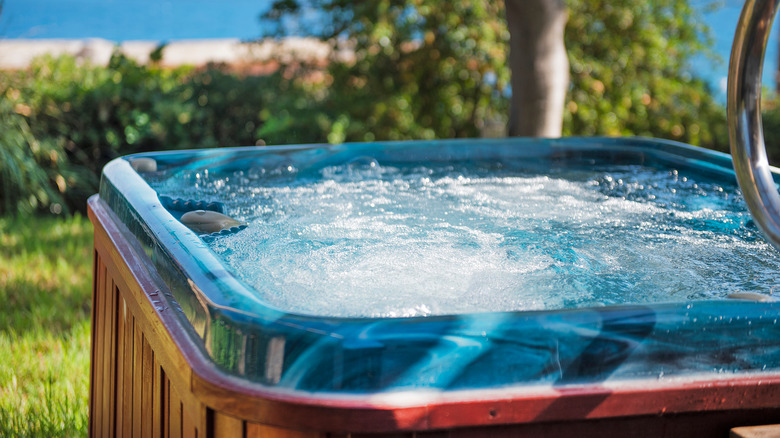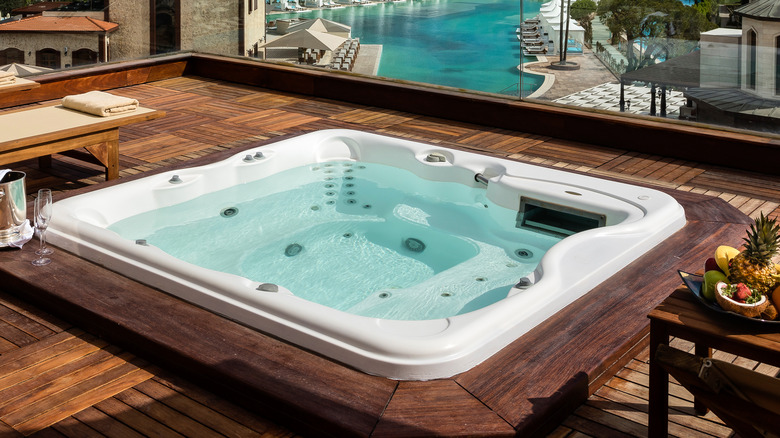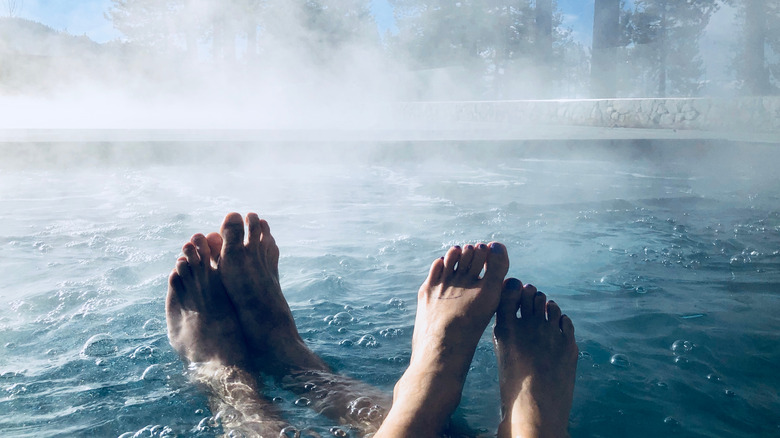The Invention Of The Jacuzzi Has A Heartbreaking Backstory
The Jacuzzi, for many, evokes feelings of luxury, comfort, extravagance. Like the general hot tubs they have become synonymous with, they are often enjoyed as a bit of treat, while at a spa or on vacation.
On TV shows, we often see merry, laughing groups in hot tubs, clutching glasses of champagne and generally living what they perceive to be their best lives. It's enough to make a person jealous, certainly, but the Jacuzzi experience isn't just about something as frivolous as that. As Healthline reports, there are instances when people should avoid using a hot tub, but for most of us, relaxing in one can have positive effects on a person's health, potentially easing muscle aches, among other benefits.
A Jacuzzi as therapeutic tools certainly isn't as outlandish a concept as it may seem. The device's very invention dates back to a worried father who sought to find an innovative way to relieve the pain his son was experiencing.
A father's love led to the Jacuzzi's invention
On October 10, 1986, The New York Times published an obituary for Candido Jacuzzi, an inventor from a large family (he had six sisters and seven brothers) that had emigrated from Italy to the United States in the 1900s. In California, the family located humble premises on which to found Jacuzzi Brothers Inc. An early success for the company was an aircraft propeller (Allied planes would go on to use the Jacuzzi-branded propeller), but the most iconic product to bear the Jacuzzi name would be the range of pumps that would eventually become the hot tubs we know today.
Candido's son Kenneth was diagnosed with rheumatoid arthritis, the outlet states, and at the close of the 1940s, there was little private access to the hydrotherapy that would bring the boy relief. What does a creative mind like Candido's do when a need is currently being unmet? Develop a brilliant invention to meet it, of course.
In his book "Jacuzzi: A Father's Invention to Ease a Son's Pain," Kenneth Jacuzzi himself tells the remarkable story in his own words. At the age of 7, Kenneth writes, he had regular appointments for such therapy at a California hospital. Of the sessions, he stated, "my parents and therapists noted that after the treatments, the warm water and massage gave me a greater ability to move my limbs with less pain. ...however, each time I traveled to a hospital for hydrotherapy, I was vulnerable to cold and flu germs."
Hot tubs seem to have healing properties
The answer, Kenneth Jacuzzi writes in "Jacuzzi: A Father's Invention to Ease a Son's Pain," was clear: "My mother, Inez, urged my father ... to invent a whirlpool pump for my everyday use at home ... he and his brothers, who ran a commercial water irrigation pump manufacturing business, started building and marketing whirlpool baths in the early 1950s."
As Jacuzzi reports, the family's pain-relieving breakthrough was the J-300, a unique pump, rather than a hot tub itself. The idea was that the J-300 was placed in a bathtub of water and would relieve aches and pains like Kenneth Jacuzzi's. Nancy Powers, IT administrator and office manager at Jacuzzi, states that such therapy does wonders for her osteoarthritis: "of all the methods I have used including deep tissue massage, a heating pad around various parts of my body, etc., hot tub therapy works best, hands down."
Today, hot tubs are sometimes dismissed as an extravagance, but it's important not to discount the difference they can make to peoples' quality of life. In March of 2017, the study "The effect of passive heating on heat shock protein 70 and interleukin-6: A possible treatment tool for metabolic diseases?" was published. In it, via Taylor & Francis Online, S. H. Faulkner et al conclude that there is "potential for thermal therapy as an alternative treatment and management strategy for those at risk of developing metabolic disease where adherence, or ability to [exercise], may be compromised."


